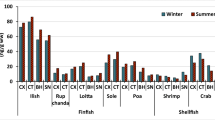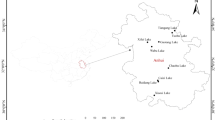Abstract
The objective of this study is to determine the concentrations of polychlorinated biphenyls (PCBs) in different fish species collected from fish outlets in the south Indian city of Hyderabad. The samples of fish extracted by using Quick, Easy, Cheap, Effective, Rugged, and Safe (QuEChERS) and concentrations of polychlorinated biphenyls (PCBs, 45 congeners) were determined by gas chromatography–microelectron capture detection (GC-μECD) method. The intake of individual PCB congeners through fish, toxicity equivalence factors (TEFs), hazardous quotient, quantitative assessment, and risk evaluations was estimated in the Indian population. Daily dietary intakes of PCBs at the 95th-percentile-measured concentrations were twice the values of the 50th-percentile-measured concentrations in all socio-economic groups. The dietary intakes of PCBs through fish consumption in middle-income group, low-income group, and industrial laborers (0.023 μg kg−1 day−1), the high-income group (0.031 μg kg−1 day−1), and slum dwellers (0.039 μg kg−1 day−1) exceeded the reference dose. The observed estimated daily intakes (EDIs) of our study for all socio-economic sections (0.0087 μg/kg/day) crossed the cancer benchmark concentration of 0.0003 μg/kg/day. In slum dwellers, the ingestion of fish from freshwater and marine water results in the highest lifetime cancer risks of 4.7 in 100,000 and 7.8 in 100,000, respectively. Ultimately, the concentrations of PCBs were determined high in all of the fish species collected. Risk assessment showed that the fish were highly contaminated with PCBs and may pose health threats to consumers in the city of Hyderabad as well as a lifetime cancer risk.





Similar content being viewed by others
References
Anastassiades, M., Lehotay, S. J., Stajnbaher, D., & Schenck, F. J. (2003). Fast and easy multiresidue method employing acetonitrile extraction/partitioning and "dispersive solid-phase extraction" for the determination of pesticide residues in produce. Journal of AOAC International, 86, 412–431. http://pubag.nal.usda.gov/pubag/downloadPDF.xhtml?id=555&content=PDF.
Baars, A. J., Bakker, M. I., Baumann, R. A., Boon, P. E., Freijer, J. I., Hoogenboom, L. A., et al. (2004). Dioxins, dioxin-like PCBs and non-dioxin-like PCBs in foodstuffs: occurrence and dietary intake in The Netherlands. Toxicology Letters, 151(1), 51–61.
Baker, E. L., Jr., Landrigan, P. J., Glueck, C. J., Zack, M. M., Jr., Liddle, J. A., Burse, V. W., et al. (1980). Metabolic consequences of exposure to polychlorinated biphenyls (PCB) in sewage sludge. American Journal of Epidemiology, 112(4), 553–563.
Bayen, S., Wurl, O., Karuppiah, S., Sivasothi, N., Lee, H. K., & Obbard, J. P. (2005). Persistent organic pollutants in mangrove food webs in Singapore. Chemosphere, 61(3), 303–313.
Betsy A., Sudershan R. V., Rao V., & Polasa K. (2010). “Consumption pattern of conventional and processed foods among various socioeconomic sections of Hyderabad.” in the 42nd Annual Conference of Nutrition Society of India (NSI):19–20.
Bradman, A., Whitaker, D., Quiros, L., Castorina, R., Claus Henn, B., Nishioka, M., et al. (2007). Pesticides and their metabolites in the homes and urine of farmworker children living in the Salinas Valley, CA. Journal of Exposure Science & Environmental Epidemiology, 17, 331–349.
Buck, G. M., Mendola, P., Vena, J. E., Sever, L. E., Kostyniak, P., Greizerstein, H., et al. (1999). Paternal Lake Ontario fish consumption and risk of conception delay, New York State angler cohort. Environmental Research, 80(2 Pt 2), S13–S18.
Coristine, S., Haffner, G. D., Ciborowski, J. J. H., Lazar, R., Nanni, M. E., & Metcalfe, C. D. (1996). Elimination rates of selected di-ortho, mono-ortho, and non-ortho substituted polychlorinated biphenyls in rainbow trout (oncorhynchusmykiss). Environmental Toxicology and Chemistry, 15(8), 1382–1387. doi:10.1002/etc.5620150818.
Dewailly, E., Ayotte, P., Bruneau, S., Gingras, S., Belles-Isles, M., & Roy, R. (2000). Susceptibility to infections and immune status in Inuit infants exposed to organochlorines. Environmental Health Perspectives, 108(3), 205–211.
Dougherty, C. P., Holtz, S. H., Reinert, J. C., Panyacosit, L., Axelrad, D. A., & Woodruff, T. J. (2000). Dietary exposures to food contaminants across the United States. Environmental Research, 84, 170–185.
Dvanathan G., Isobe T., Subramanian A., Annamalai S.,& Kwadwo Ansong A. (2012). Contamination Status of Polychlorinated Biphenyls and Brominated Flame Retardants in Environmental and Biota Samples from India. Interdisciplinary Studies on Environmental Chemistry—Environmental Pollution and Ecotoxicology, pp. 269–277.
Eqani, S., Malik, R. N., Cincinelli, A., Zhang, G., Mohammad, A., Qadir, A., et al. (2013). Uptake of organochlorine pesticides (OCPs) and polychlorinated biphenyls (PCBs) by river water fish: the case of River Chenab. Science of the Total Environment, 450-451, 83–91. doi:10.1016/j.scitotenv.
Fein G. G., Jacobson J. L., Jacobson S. W., Schwartz P. M., & Jeffrey K. (1984). Prenatal exposure to polychlorinated biphenyls: Effects on birth size and gestational age. Journal of Pediatrics, 315–320. DOI: 10.1016/S0022-3476(84)80139-0
Fromberg, A., Granbya, K., Højgårdb, A., Fagta, S., & Larsena, J. C. (2011). Estimation of dietary intake of PCB and organochlorine pesticides for children and adults. Food Chemistry, 125(4), 1179–1187.
Fromme, H., Tittlemier, S. A., Volkel, W., Wilhelm, M., & Twardella, D. (2009). Perfluorinated compounds—exposure assessment for the general population in Western countries. International Journal Hygiene Environmental Health, 212, 239–270.
Jacobson, J. L., Jacobson, S. W., Padgett, R. J., Brumitt, G. A., & Billings, R. L. (1992). Effects of prenatal PCB exposure on cognitive processing efficiency and sustained attention. Developmental Psychology, 28(2), 297–306.
Johnson-Restrepo, B., Kannan, K., Rapaport, D. P., & Rodan, B. D. (2005). Polybrominated diphenyl ethers and polychlorinated biphenyls in human adipose tissue from New York. Environmental Science & Technology, 39(14), 5177–5182.
Kalina, I., Sram, R. J., Konecna, H., & Ondrusseková, A. (1991). Cytogenetic analysis of peripheral blood lymphocytes in workers occupationally exposed to polychlorinated biphenyls. Teratogenesis, Carcinogenesis, and Mutagenesis, 11(2), 77–82.
Kimbrough, R. D., Doemland, M. L., & LeVois, M. E. (1999a). Mortality in male and female capacitor workers exposed to polychlorinated biphenyls. Journal of Occupational and Environmental Medicine, 41(3), 161–171.
Kreiss, K. (1985). Studies on populations exposed to polychlorinated biphenyls. Environmental Health Perspectives, 60, 193–199.
Looser, R., & Ballschmiter, K. (1998). Biomagnification of polychlorinated biphenyls (PCBs) in freshwater fish. Fresenius' Journal of Analytical Chemistry, 360, 816–819.
Loutfy, N., Fuerhacker, M., Tundo, P., Raccanelli, S., El Dien, A. G., & Ahmed, M. T. (2006). Dietary intake of dioxins and dioxin-like PCBs, due to the consumption of dairy products, fish/seafood and meat from Ismailia city, Egypt. Science of the Total Environment, 370(1), 1–8.
Marin, S., Villalba, P., Diaz-Ferrero, J., Font, G., & Yusà, V. (2011). Congener profile, occurrence and estimated dietary intake of dioxins and dioxin-like PCBs in foods marketed in the Region of Valencia (Spain). Chemosphere, 82(9), 1253–1261.
Mendola, P., Buck, G. M., Vena, J. E., Zielezny, M., & Sever, L. E. (1995). Consumption of PCB-contaminated sport fish and risk of spontaneous fetal death. Environmental Health Perspectives, 103, 498–502.
Mendola, P., Buck, G. M., Sever, L. E., Zielezny, M., & Vena, J. E. (1997). Consumption of PCB-contaminated freshwater fish and shortened menstrual cycle length. American Journal of Epidemiology, 146(11), 955–960.
National Implementation Plan, Government of India. (2011). http://chm.pops.int/ Implementation/NIPs/NIPSubmissions/ tabid/253/ctl/Download/mid/3061/Default.as px?id=78
Nie, X., Lan, C., Wei, T., & Yang, Y. (2005). Distribution of polychlorinated biphenyls in the water, sediment and fish from the Pearl River estuary, China. Marine Pollution Bulletin, 50(5), 537–546.
Oliver, B. G., & Niimi, A. J. (1988). Trophodynamic analysis of polychlorinated biphenyl congeners and other chlorinated hydrocarbons in the Lake Ontario ecosystem. Environmental Science and Technology, 22, 388–397.
Pham, T. H., Nguyen, M. T., Go, S., Shin, T., & Shinsuke, T. (2012). Polychlorinated Biphenyls and Polybrominated Diphenyl Ethers in Fishes Collected from Tam Giang-Cau Hai Lagoon, Vietnam. Interdisciplinary Studies on Environmental Chemistry—Environmental Pollution and Ecotoxicology, 221–227.
Roosens, L., Alin, C., Goemans, G., Belpaire, C., Gheorghe, A., Neels, H., et al. (2008). Brominated flame retardants and polychlorinated biphenyls in fish from the river Scheldt, Belgium. Environment International, 34, 976–983.
Sasamoto, T., Ushio, F., Kikutani, N., Saitoh, Y., Yamaki, Y., Hashimoto, T., et al. (2006). Estimation of 1999–2004 dietary daily intake of PCDDs, PCDFs and dioxin-like PCBs by a total diet study in metropolitan Tokyo, Japan. Chemosphere, 64(4), 634–641.
Stewart, A. G., & Carter, J. (2009). Towards the development of a multidisciplinary understanding of the effects of toxic chemical mixtures on health. Environmental Geochemistry and Health, 31, 239–251.
Sudaryanto, A., Monirith, I., Kajiwara, N., Takahashi, S., Hartono, P., Muawanah, et al. (2007). Levels and distribution of organochlorines in fish from Indonesia. Environmental International, 33(6), 750–758.
Tard, A., Gallotti, S., Leblanc, J. C., & Volatier, J. L. (2007). Dioxins, furans and dioxin-like PCBs: occurrence in food and dietary intake in France. Food Additives and Contaminants, 24(9), 1007–1017.
Törnkvist, A., Glynn, A., Aune, M., Darnerud, P. O., & Ankarberg, E. H. (2011). PCDD/F, PCB, PBDE, HBCD and chlorinated pesticides in a Swedish market basket from 2005—levels and dietary intake estimations. Chemosphere, 83, 193–199.
USEPA. (2000). Phase 2 report further site characterization and analysis volume 2F-Revised human health risk assessment Hudson river PCBs reassessment RI/FS. http://www3.epa.gov/hudson/revisedhhra-text.pdf. Accessed 29 Nov 2000.
Weijs, L., Dirtu, A. C., Das, K., Gheorghe, A., Reijnders, P. J., Neels, H., Blust, R., & Covaci, A. (2009). Inter-species differences for polychlorinated biphenyls and polybrominated diphenyl ethers in marine top predators from the Southern North Sea: Part 1. Accumulation patterns in harbour seals and harbour porpoises. Environmental Pollution, 157, 437–444.
Yanez, L., Ortiz, D., Calderon, J., Batres, L., Carrizales, L., Mejia, J., et al. (2002). Overview of human health and chemical mixtures: problems facing developing countries. Environmental Health Perspectives, 110, 901–909.
Zhang, J., Liu, F., Chen, R., Feng, T., Dong, S., & Shen, H. (2012). Levels of polychlorinated biphenyls and organochlorine pesticides in edible shellfish from Xiamen (China) and estimation of human dietary intake. Food and Chemical Toxicology, 50(12), 4285–4291. doi:10.1016/j.fct.08.052.
Acknowledgments
The authors would like to take this opportunity to express their heartfelt gratitude to Dr. V.M. Katoch, Secretary, Department of Health Research and Director General, Indian Council of Medical Research for granting us the opportunity to work on this project. The authors are also thankful to the Director, National Institute of Nutrition, ICMR for providing encouragement and attention. The authors are very grateful to Dr. Vishwa Mohan Katoch, Director General, ICMR for funding this work.
Author information
Authors and Affiliations
Corresponding author
Rights and permissions
About this article
Cite this article
Ahmed, M.N., Sinha, S.N., Vemula, S.R. et al. Accumulation of polychlorinated biphenyls in fish and assessment of dietary exposure: a study in Hyderabad City, India. Environ Monit Assess 188, 94 (2016). https://doi.org/10.1007/s10661-015-5068-3
Received:
Accepted:
Published:
DOI: https://doi.org/10.1007/s10661-015-5068-3




